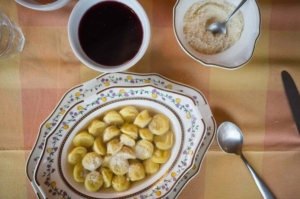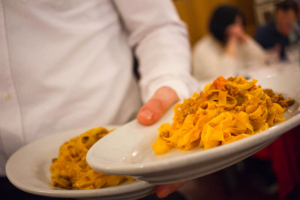The Best Tortellini in Bologna: Where to eat them and the Authentic Recipe
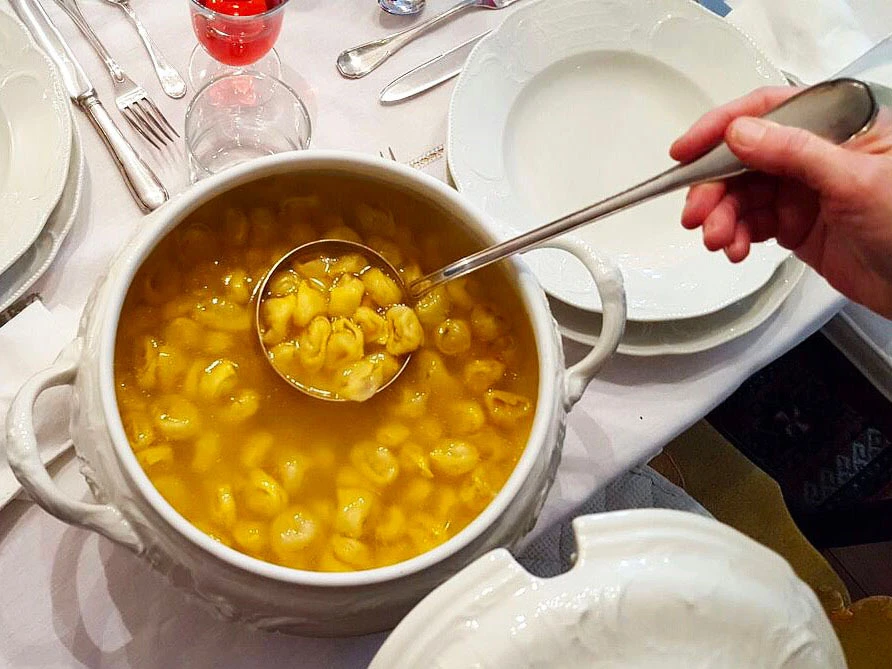
Few dishes can whisper history, spark debates, and comfort your soul in a single spoonful—but tortellini can.
From festive broths to gourmet twists, tortellini have traveled through centuries and kitchens, always remaining at the heart of Emilia-Romagna’s culinary identity.
But what makes them so special?
Why do people argue about their origin?
And—perhaps most importantly—where can you taste the best tortellini in Bologna?
In this guide, you’ll discover how they’re made, where to find the best tortellini in Bologna, and why this tiny pasta holds such a big place in Italian food culture.
Curious? Let’s begin.
What are Tortellini? A bite of tradition
Ask someone from Bologna what pasta defines their city, and they won’t shout it—they’ll smile and softly say: tortellini.
Delicate golden rings, folded with care and centuries of know-how, these little parcels may be small, but they carry the weight of tradition, family, and pride.
In Bologna, there’s only one sacred way to serve them: gently floating in a steaming broth—rich, clear, and soul-warming. The kind of dish that doesn’t just feed you, but hugs you.
How do you eat tortellini in Italy?
Slowly. Reverently. One spoonful at a time.
Let the flavor, the heat, and the heritage sink in.
Sure, there are variations—but be warned: in Bologna, serving them any other way can spark debates... or end friendships.
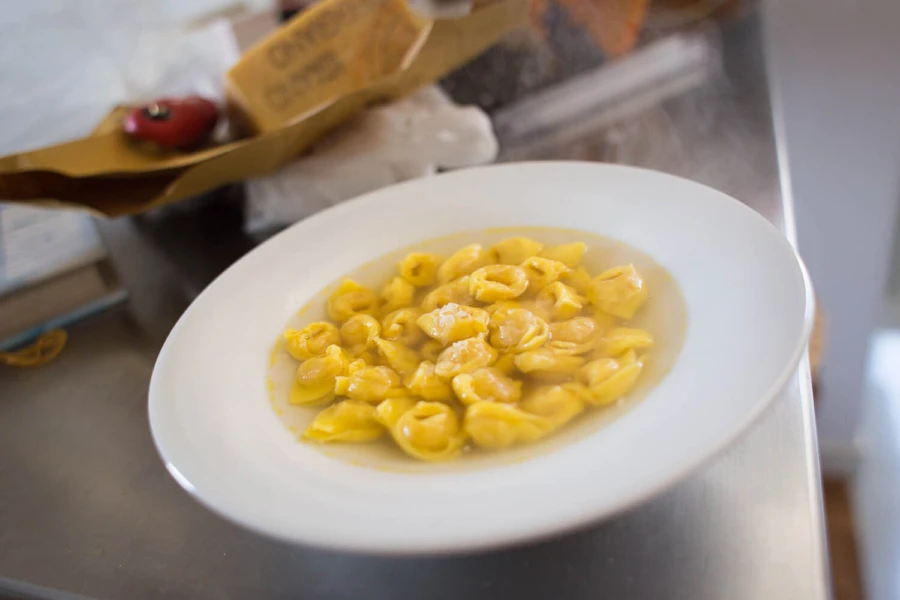
Origin and history of Tortellini
Tortellini have medieval roots, though their exact origin is still debated.
Some say they were born in 1095 in Bologna, created to honor crusaders before they left for the Holy Land.
The first written mention?
A story from 1289, when a student caught roaming the streets at night claimed he was simply out to buy tortellos for himself and his friends.
In the 12th century, historian Cervellati described Tortellum ad Natale, likely sweet pasta served to monks, not quite the tortellini we know.
By the 1300s, a Modenese recipe mentioned torteleti de enula, and even Boccaccio, in the Decameron, hinted at stuffed pasta. The name may come from torta or tortula, but no one knows for sure.
Myths, legends, and global fame
Over the centuries, tortellini moved from noble feasts to family kitchens, becoming the heart of festive meals.
The iconic mortadella? It only entered the filling in the 1800s.
That same century, engineer Paolo Ceri from Castelfranco Emilia invented the famous “Venus’s navel” legend—pure fiction, but now part of local lore. The town even hosts a Tortellino Festival every September to celebrate it.
In 1904, the Bertagni brothers introduced tortellini to the world stage at the Los Angeles Exposition, along with a method for preserving them.
Then in 1974, the Dotta Confraternita del Tortellino sealed tradition by registering the official recipe: meat-filled tortellini served in rich broth.
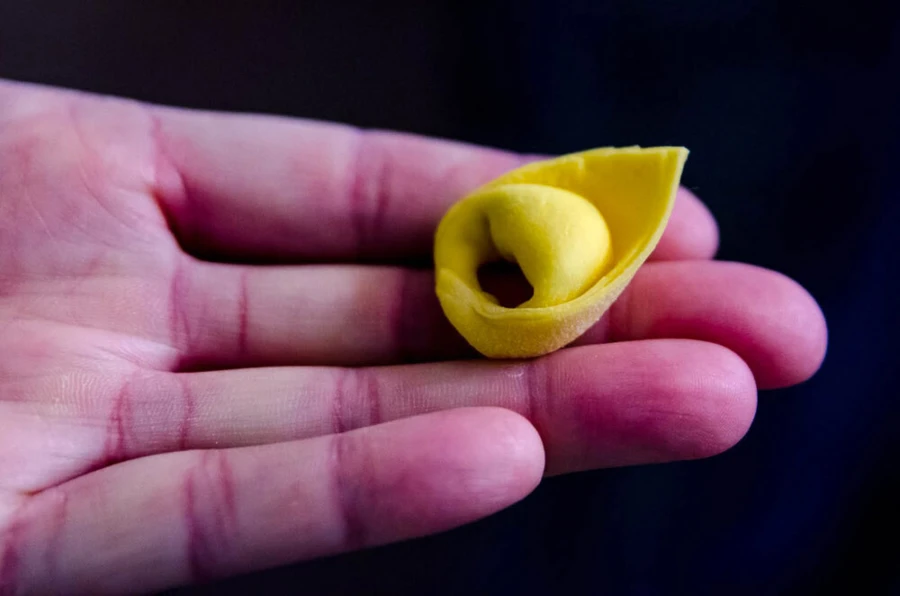
The recipe of Tortellini
Ingredients (for approx. 1000 tortellini)
For the pasta dough:
-
1 kg all-purpose flour
-
10 fresh eggs
For the filling:
-
300 g pork loin (lombo di maiale)
-
300 g prosciutto crudo
-
300 g authentic mortadella di Bologna
-
450 g Parmigiano Reggiano (aged at least 24 months)
-
3 eggs
-
A pinch of grated nutmeg
For the broth:
-
1 kg beef (doppione, or shoulder/brisket cut)
-
½ free-range chicken (preferably a hen)
-
1 carrot
-
1 celery stalk
-
1 onion
-
Salt to taste
Step 1: Preparing the pork loin
Authentic tortellini filling starts with care, patience, and seasoning. The pork loin isn’t just cooked—it’s marinated and rested.
-
Rub the pork loin with a mix of salt, freshly ground black pepper, finely chopped rosemary, and garlic.
-
Cover and let it rest in the fridge for 48 hours, allowing the flavors to penetrate deeply.
-
After the rest, melt a little butter in a pan and slowly brown the meat over low heat until tender and fragrant.
-
Remove it from the pan, let it cool slightly, and carefully clean off the marinade (you want the flavor, not the chunks).
Step 2: Making the filling
Now it’s time to transform those flavors into the heart of your tortellini.
-
Finely mince the pork loin, prosciutto, and mortadella. For best results, use a battilardo (traditional mezzaluna chopper and board) or a sharp knife. Avoid using food processors—they heat the meat and ruin the texture.
-
Place the minced meat in a large bowl.
-
Add grated Parmigiano Reggiano, the eggs, and a generous pinch of nutmeg.
-
Mix thoroughly by hand. Keep going until the mixture is smooth, compact, and evenly blended.
-
Cover the bowl and let the filling rest for 24 hours in the fridge. This step is essential—it allows the ingredients to bind and the flavors to mature.
Step 3: Making the broth
A great tortellino deserves a broth that does it justice. Clear, rich, and aromatic—brodo is not just a side, it’s the soul of the dish.
-
Place the beef and hen in a large pot with celery, carrot, onion, and a pinch of salt.
-
Cover with cold water and bring to a gentle simmer over low heat.
-
Skim off any foam, then let it cook slowly for at least 3 hours.
-
Strain the broth, removing all solids, and keep warm.
Step 4: Rolling the pasta
Fresh egg pasta is the canvas of the tortellino.
-
On a floured surface, mix the flour and eggs, kneading until smooth and elastic.
-
Let the dough rest under a cloth for 30 minutes.
-
Roll it out very thin (ideally by hand with a mattarello), almost translucent but still strong enough to hold the filling.
-
Cut the dough into 3–4 cm squares using a knife or pasta cutter.
Step 5: Folding the Tortellini
Time to shape the magic.
-
Place a small ball of filling in the center of each square.
-
Fold the square into a triangle, pressing the edges to seal.
-
Wrap the two tips of the triangle around your finger and pinch them together to form the classic “navel” shape.
Step 6: Cooking and serving
-
Bring your broth to a gentle boil.
-
Drop the tortellini in and cook for about 3–4 minutes, until they rise to the surface.
-
Serve immediately in a bowl of hot broth, with a sprinkle of Parmigiano Reggiano if desired.
Cooking methods and variations of Tortellini
Traditionally served in brodo, tortellini also appear in other forms across Bologna:
-
With cream, a decadent version popularized in the 1980s, still served in many restaurants. Ideal for kids and during summer.
-
In a Parmigiano cream sauce, rich and comforting.
-
As a base for creative dishes during the Tortellino Festival, where chefs experiment with new fillings and sauces.
Gluten-free tortellini are hard to make, but still delicious to eat.
True vegetarian tortellini don’t exist in tradition, but you can try tortelloni—their larger cousin with ricotta and parsley.
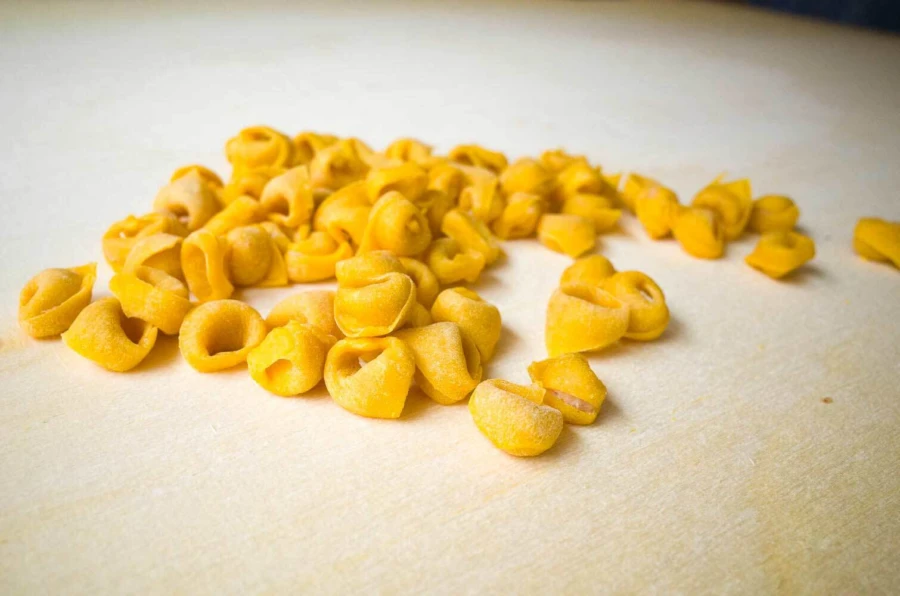
Where to eat Tortellini
The best Tortellini in Bologna
Looking for the best tortellini in Bologna? Here are a few places locals swear by:
-
Osteria Bottega – for textbook perfection in broth.
-
Caminetto d’Oro – refined presentation and balance.
-
Trattoria da Cesari – rustic and full of character.
-
Sandro al Navile – elegant tortellini with a perfect bite.
-
Grassilli – old-world charm, homemade style.
-
Darcy – creative, seasonal interpretations.
-
Il Mirasole – legendary for tortellini con la panna.
Where to buy Tortellini in Bologna
Prefer to cook or take some home? These shops are the real deal:
-
Atti – artisanal and historic (since 1880).
-
Tamburini – beloved deli with top-quality pasta.
-
Le Sfogline – handmade, from scratch.
-
Salumeria Bruno e Franco – tiny and perfect.
Explore them all in one go with a visit to the city’s bustling Bologna food markets.
Learn to make Tortellini in a Bologna Cooking Class
If you're looking to do more than eat, why not learn to make tortellini with a local artisan?
Join our Bologna cooking class to get your hands-on experience in pasta-making, from dough to brodo.
Plus, you’ll go home with a skill to show to your friends and family!
Tortellini vs. Tortelloni: know the difference
What is the difference between tortellini and tortelloni?
Let’s break it down:
So next time you see both on a menu, you'll know exactly what you’re ordering ;)
Conclusion: a love letter to Tortellini
Under Bologna’s arcades, rolling pins tap like church bells. In a back-room kitchen, floured hands flip a pasta square—twist, pinch, click—into a golden ring.
It sinks into bubbling broth - steam rises, scented with hen, bone, Parmigiano and nutmeg.
Your bowl trembles: first spoonful, silk and depth.
Second bite, filling melts.
Third, you’re inside the city’s heartbeat.
Join our Bologna food tour to watch sfogline shape miracles, breathe the clouded windows of broth, then cradle your own bowl of tortellini in brodo.
Some memories hang on walls.
The best drift on steam—come claim yours, one spoonful at a time.
Bibliography
Sua Maestà il Tortellino - Giorgio Maioli, Giancarlo Roversi - Re Enzo Editrice 1993

